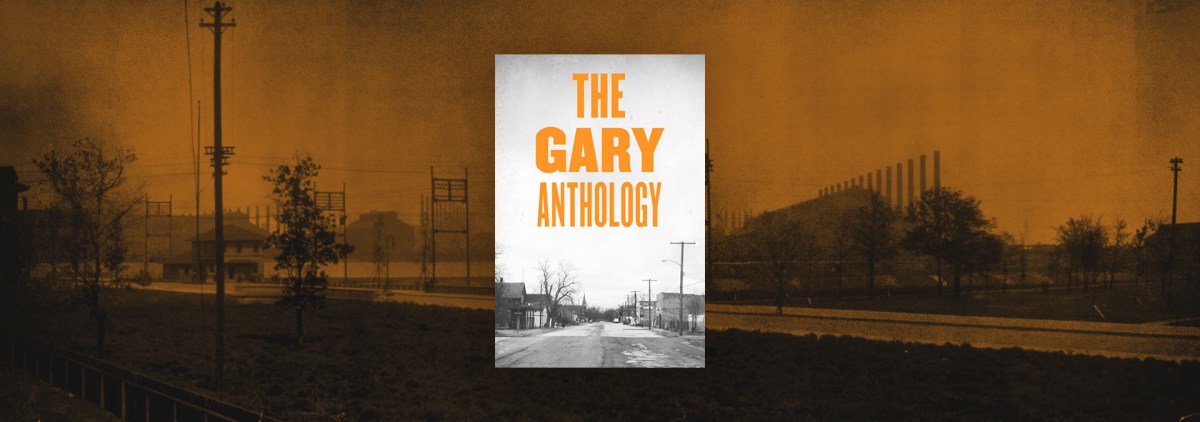[ad_1]
Founded in 1906, the history of Gary, Indiana, has curious, layered aspects, comprised of silt, slag, and blood. You gain access to it in a car ride, your passenger noting, “My family used to own that building…” You overhear it in an impromptu conversation, a shared recollection of close detail and laughter. You cross it in the city’s geographical and sonic boundaries, with muffled beats and long vacant lots. And it is those histories that The Gary Anthology, edited by Samuel A. Love, collects in a strong series of personal essays, historical exploration, nature writing, and photography.
The geographies and identity of Gary are difficult to pin down. In his introduction, Love writes, “We are continuously fringed…Black and scary, not really ‘Hoosier’ or truly ‘heartland,’ a place to avoid, despite the shared geography. We are unlike either [Chicago or Indiana] and therefore suspect to both”. The anthology returns often to those “suspect” qualities—how Gary holds a peripheral place in the American imagination, both the chorus of a Broadway ditty and the blast furnace from which the modern city of steel-reinforced expressway has emerged. A Rust Belt capital, Gary is neither Chicago suburb nor middle-American city. Gary is the habitation formed by the contradictions that mark the present shape of the American experiment—terminus of (im)migration and space of flight, a slick and violent metropolis as well as memoried homeplace. The city’s historical and very present silence complicate any easy recollection of that American “city on a hill.”
One of the primary themes of the anthology is Gary as the politically complex Black metropolis, a city that elected its first Black mayor, Richard Hatcher, in 1967 and served as setting of the initial National Black Political Convention in 1972. There, at Gary’s West Side High School, participants including Jesse Jackson, Dick Gregory, Amiri Baraka, and Muhammad Ali argued the central issues of Black engagement within American politics and culture. Within these wider histories though, the anthology writers explore more basic civic impulses, such as memories of kitchen-table organizing for Hatcher’s first campaign as well as Gary’s present economic boundaries, political dysfunction, and conflicts. Exploring these intricacies in another essay, Kwabena Sakidi Jijaga Rasuli relates his frustrations with the city’s political process as he more recently attempts to get the city to name a street for Malcolm X.
As Love notes, Gary is also “the city where nature was never fully subdued.” The Indiana Dunes press against the city’s edges, and trees sprout in vacant lots as well as within and through crumbling structures. Its boundaries in slow and losing negotiation with the natural world, Gary’s grid is a mix of urban and weedy spaces, a topic explored by many of the anthology writers. Charting nature’s own renewal in a great hike, Michael McColly gathers the post-industrial detritus along the Dunes Highway. Across the city, Kay Westhues examines the history of a public spring in Gary’s southwest side neighborhood, Small Farms. What emerges in these essays is a twentieth-century city mapped against a wider history of commercial growth and natural loss. Is Gary a human space existing on the peripheries of a Great Lakes ecosystem or a series of micro-ecosystems holding on against the ravages of relatively recent human incursion through the past century? These essays allow the local complexities to emerge and remain with the reader, a re-measuring of human boundaries in an existent wetland.
Gary’s narratives also reflect migration and flight, conflict and compromise. Too easily, the city’s complex histories dissolve within outsider and racialized cliché. Within Love’s editorial work, memory gets traction against the broad generalizations that too often define present depictions of “failed” or “disappearing cities” in American political rhetoric. Many of these essays reflect the force and importance of oral histories. The journeys of migration and the dangerous work of steelmaking are voiced in the clarity offered by place. Storefronts, back trails, and neighborhoods are invoked with great seriousness as well as underlying joy. Reflected by Raymar Brunson’s outstanding photographs in the book, these Gary stories are told with complexity and authority.
In her essay on Richard Hatcher, Dena Holland-Neal expresses a core focus within the anthology: “One of the things that hurts me the most right now is that people here don’t know [Gary’s] history. They look at us as a shattered place…[T]hey don’t see anything good coming out of Gary.” In the contexts of migration and lost work in the larger Midwest, Gary’s stories are essential reading. Narratives of the “Rust Belt” have often been oversimplified or glossed for political impact. The Gary Anthology reclaims cultural memory as an impulse for exploring the complexities of shared and forgotten places. Chicagoans will discover a new local map, one that extends the place and time of a peripheralized “South Shore,” a space one travels through or across on the way to elsewhere. Readers outside this region will also recognize these voices in their striving to understand the social, political, and commercial forces that passed through the wider “Rust Belt” on their way to the twenty-first century.
Travelling on Broadway, one of Gary’s central thoroughfares, a driver eventually crosses I-80/94, eight lanes of brusque transit. At this intersection, the driver is offered the choice: the expressway east to Detroit or west to Chicago. Gary is somewhere between, both on the map and in its sharp, enduring story. Love’s anthology gathers this resilience without shying away from the city’s hard realities.

Nonfiction
The Gary Anthology
Samuel A. Love (editor)
Belt Publishing
September 15, 2020
[ad_2]
Source link
